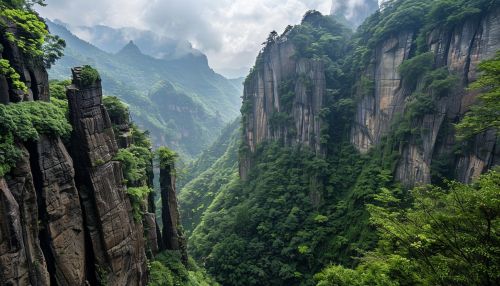Mount Hua
Overview


Mount Hua (华山, Huà Shān) is one of the most renowned mountains in China, located in the Shaanxi province. It is part of the Qinling mountain range and is known for its steep and perilous paths, as well as its significant cultural and historical importance. Mount Hua is one of the Five Great Mountains of China, which are considered sacred in Chinese culture. The mountain is famous for its dramatic cliffs, ancient temples, and breathtaking scenery.
Geography and Geology
Mount Hua is situated approximately 120 kilometers east of Xi'an, the capital of Shaanxi province. The mountain consists of five main peaks, each with its own unique characteristics:
- **East Peak (Zhaoyang Peak)**: Known for its sunrise views.
- **South Peak (Landing Wild Goose Peak)**: The highest peak, standing at 2,154 meters above sea level.
- **West Peak (Lotus Flower Peak)**: Named for its lotus-like appearance.
- **North Peak (Cloud Terrace Peak)**: The lowest of the five peaks.
- **Central Peak (Jade Maiden Peak)**: Associated with various legends and myths.
The mountain is primarily composed of granite, which contributes to its rugged and steep terrain. The geological formation of Mount Hua dates back to the Mesozoic era, and its current landscape has been shaped by millions of years of tectonic activity and erosion.
Historical Significance
Mount Hua has been a site of religious and cultural significance for over two millennia. It is home to numerous Taoist temples, pavilions, and shrines. The mountain has been a place of pilgrimage for Taoists, Buddhists, and Confucians alike. Some of the most notable temples include:
- **Jade Spring Temple**: Located at the base of the mountain, it is dedicated to Chen Tuan, a famous Taoist hermit.
- **Yuquan Courtyard**: A complex of Taoist temples and pavilions.
- **Xiyue Temple**: One of the largest and oldest Taoist temples on the mountain.
Mount Hua is also associated with various legends and myths. It is said to be the home of the deity Xiyue Dadi, one of the Five Great Emperors of Taoism. The mountain has been mentioned in numerous classical Chinese texts and poems, further cementing its cultural importance.
Climbing and Tourism
Mount Hua is renowned for its challenging and dangerous hiking trails. The most famous route is the "Plank Walk in the Sky," a narrow wooden walkway attached to the side of a cliff. Despite its perilous nature, the plank walk attracts many adventurous tourists each year.
There are several routes to ascend the mountain, including:
- **The Traditional Route**: Starting from the Jade Spring Temple, this route involves a steep climb with numerous steps and narrow paths.
- **The Cable Car Route**: For those who prefer a less strenuous ascent, there are cable cars that transport visitors to the North and West Peaks.
The mountain is also known for its natural beauty, with lush forests, clear streams, and diverse flora and fauna. The scenic views from the peaks are breathtaking, offering panoramic vistas of the surrounding landscape.
Flora and Fauna
Mount Hua is home to a rich diversity of plant and animal life. The mountain's varied climate and altitude create a range of habitats, supporting numerous species. Some of the notable flora includes:
- **Chinese Pine (Pinus tabuliformis)**: A common tree species found on the mountain.
- **Rhododendron**: Various species of this flowering plant are found in the higher altitudes.
- **Chinese Yew (Taxus chinensis)**: A rare and protected tree species.
The fauna of Mount Hua includes:
- **Golden Snub-nosed Monkey (Rhinopithecus roxellana)**: An endangered primate species.
- **Leopard (Panthera pardus)**: Though rare, leopards are occasionally sighted in the region.
- **Various bird species**: Including the Chinese Bamboo Partridge and the Golden Eagle.
Cultural Impact
Mount Hua has had a profound impact on Chinese culture and literature. It has been a source of inspiration for poets, artists, and writers throughout history. The mountain is frequently depicted in traditional Chinese paintings and has been the subject of many poems by famous poets such as Li Bai and Du Fu.
The mountain's cultural significance extends to modern times, with numerous films, television shows, and books featuring Mount Hua. It remains a popular destination for both domestic and international tourists, drawn by its natural beauty and historical importance.
Conservation and Preservation
Efforts to preserve Mount Hua's natural and cultural heritage have been ongoing. The mountain is protected as a national park, and various measures have been implemented to manage tourism and minimize environmental impact. These measures include:
- **Limiting the number of visitors**: To reduce the strain on the mountain's ecosystem.
- **Maintaining and repairing trails**: Ensuring the safety of hikers and preserving the natural landscape.
- **Promoting sustainable tourism**: Encouraging eco-friendly practices among visitors and local businesses.
See Also
- Qinling Mountains
- Taoism
- Five Great Mountains of China
- Xi'an
- Li Bai
- Du Fu
- Chinese Pine
- Golden Snub-nosed Monkey
